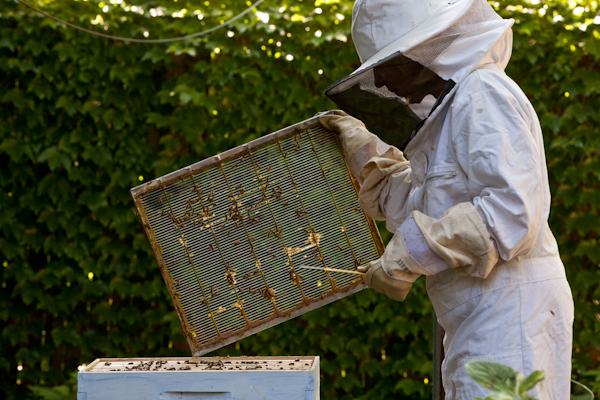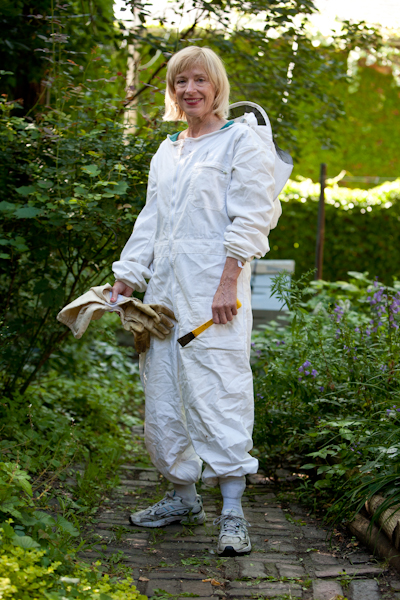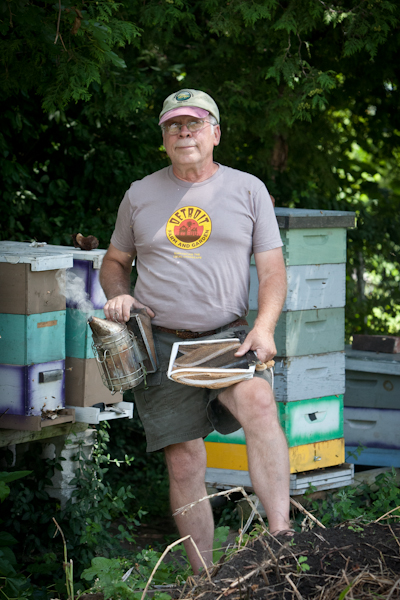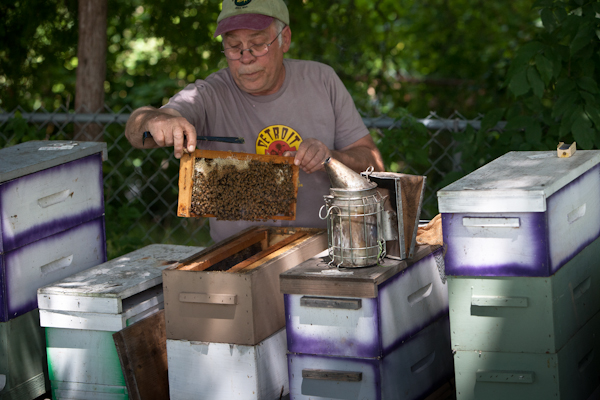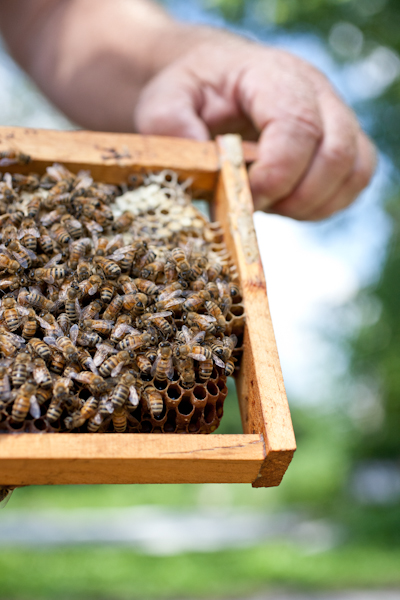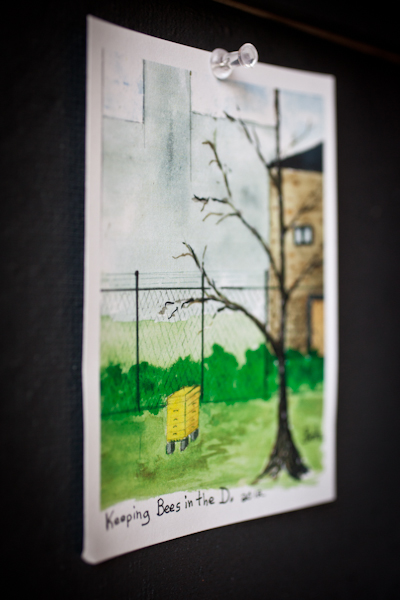Green City Diaries: Honeybee buzz
A resurgence in urban beekeeping is part of a return to the agricultural practices we had in cities in the 1930s and 1940s. New York, Paris, Detroit and other urban areas are leading a movement back to greater biodiversity, says our sustainability diarist Matthew Piper.
The day before we get together to talk about her honeybees, Bette Huster calls to tell me she’s lost one of two hives she keeps in the city. “It’s colony collapse,” she says. “A few days ago, there were more than 10,000 bees. Now they’re mostly gone. There are still a couple hanging around, but production has ceased, if you will.”
We visit the hive the next day and sure enough, the scene before us is entirely different than the one at her other hive a few miles away, which teems with the purposeful, collective labor of thousands of bees. Here, it’s still and quiet. We can see five or six bees crawling on the outside, but also flies — a bad sign.
I ask Bette what happened. Where did all the bees go? She shrugs. “I have a theory.” An industrial operation nearby recently cleared a neighboring field of dandelions. If the bees ingested the chemicals used to kill the dandelions, their “GPS system,” as Bette puts it, might have been damaged. After that, “maybe one set of bees went out foraging, and they couldn’t find their way back. Then another went out, and they couldn’t find their way back.” But that’s just a guess.
Research into the causes of colony collapse disorder (CCD), which has been drastically reducing honeybee populations in North America and Europe since 2006, is ongoing. One likely cause seems to be an increase in the use of neonicotinoids, pesticides chemically related to nicotine. (So likely that just a few months ago, the European Union began enforcing a two-year ban on the chemicals.) There are other possible (and possibly interrelated) causes: mites, parasites, malnutrition, habitat loss. In large-scale commercial beekeeping, which has been hit especially hard by CCD, the cultivation of crop monocultures is a suspect.
But even before anyone had started talking about CCD in earnest, honeybees in North America were having a hard time. Roger Sutherland, the president of the Southeast Michigan Beekeepers Association (SEMBA), tells me that the problems started in the 1980s. That’s when the varroa mite and nosema parasite began wreaking havoc on honeybee colonies; 30 years later, both remain a serious threat.
In Michigan, harsh winters have been another significant problem. Honeybees stick around when the cold weather settles, burrowing deep inside their hives to keep each other warm. There are ways that beekeepers can winterize hives, but some loss is almost inevitable. The feral bee population, meanwhile, is particularly susceptible to winter loss.
The long and short of it is that apis mellifera, the European honeybee that was brought to North America by English colonists in 1622 and has thrived here for centuries, is in trouble. And over the decades, as honeybees’ health has become more and more threatened, the practice of small-scale beekeeping has declined, especially in cities — until now.
“We’re seeing a real resurgence in urban beekeeping,” Roger Sutherland tells me optimistically. “It’s not new, of course. We’re just returning, as a society, to some of the agricultural practices we had in cities in the 1930s and 1940s. But in the last 10 years, people in cities like New York and even Paris are really bringing it back.”
Detroit has some skin in the game too. Rich Wieskie, who has been raising honeybees in the city for more than a decade, currently maintains 100 hives in Detroit, give or take, with about 30,000 bees calling each hive home. He estimates the total number of hives in the city to be somewhere between 500 and 600. (It’s hard to know for sure, though, since beekeeping is not exactly legal in Detroit at the moment. It’s not exactly illegal, either. More like…extralegal.) “When we get back up to 2,000 hives, the number Detroit had in the ’30s,” Rich says, “then I’ll retire. Or take a vacation.”
12 years ago, when he started his work as a beekeeper (“apiarist” is the technical term), Rich made mead, also known as honey wine, and was looking mainly for an inexpensive honey source. These days, meadmaking is well behind him; he’s too busy taking care of his “sweeties,” as he calls his bees, as well as teaching beekeeping classes and mentoring beginner apiarists throughout the region.
Rich is passionate about the fundamental role that honeybee pollination plays in a healthy, diverse urban ecosystem. “Honeybees are nature’s perfect ecological warriors,” he says. “They do no harm to the environment. They promote biodiversity. You have bees in an urban environment, you get more plants, more flowers, more fruit, more nuts, cleaner air. All that in return brings more insects, more bees, more mammals. It’s this whole circle. Ecologically, there’s probably nothing better than bees: what they give and what they do to sustain life.”
Rich tells me a story about a friend he helped start raising bees some time ago. She had a Japanese cherry bush in her yard, and before she started beekeeping, “she had just a few cherries on the bush. After the bees, she had so many that she could make pounds of jam throughout the season.”
Bette Huster tells a similar story. She has only recently started raising bees in the city; before that, she tried her hand on a few acres up north. “There were always wildflowers on the land,” she says, “but once the bees started pollinating, the wildflowers got explosively prolific. I went from having around 200 Canada anemones to something like 10,000.”
While Rich has made a career out of beekeeping, Bette, like most apiarists in Detroit, is a hobbyist. (By day she’s an attorney, working out of the same Cass Corridor office that she has since the 1970s). When I ask what draws her to beekeeping, she says she’s come to think of it as a kind of meditation. “When you start working in the hive, you have to go small. You have to be really careful as you put yourself in this whole other world. Plus, the bees are just fascinating: how they organize themselves, how they reproduce, how they collect and use pollen and nectar. There are so many different kinds of insects around, after all, it’s nice to have the opportunity to really get to know one.” (Bette also finds artistic inspiration in her honeybees. Check out the beekeeping-themed holiday card she made in the gallery on the left.)
Rich shares Bette’s take on the meditative quality of beekeeping. “For me, it’s therapy. It’s very calming. When you work with bees you have to be in a kind of zen state. You can’t be frenetic, because if you are, they’ll let you know they’re not happy with you. Beekeeping also puts you more in tune with the natural world. It encourages you to think of the environment in a more holistic way, a healthier way.”
It’s not exactly intuitive, when a honeybee buzzes by on the sidewalk or lands on a flower in the garden, how connected we are; the bee does its thing, we do ours.
But according to the Rodale Institute, an influential organic agriculture research organization, “our current food system is balanced precariously on the back of the honeybee. More than 70 of the 100 crops that provide 90 percent of the world’s food are pollinated by bees. Blueberries and cherries are 90-percent dependent and almonds entirely dependent on the honeybee for pollination.”
Globally, it’s clear that we need honeybees to keep essential crops productive. Locally, we need their help to make Detroit greener, more biodiverse, more literally fruitful. And individually, my conversations with local beekeepers suggest, honeybees have the power to help us find focus, stillness, and a sense of real connectedness to the natural world.
In return, the bees need our help to survive. And, with a little luck and a lot of care, to thrive.
Green City Diaries is a co-production of Model D and the Green Garage Urban Sustainability Library. Want to know more about honeybees & beekeeping in Detroit? Get started with our Urban Beekeeping resource page.
